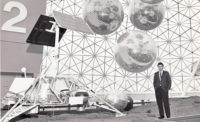The Competition features the offices of five starchitects—Frank Gehry, Dominique Perrault, Zaha Hadid, Norman Foster, and Nouvel—as they fight to win the commission for the first National Museum of Art in Andorra, a tiny country of fewer than 100,000 people sandwiched between Spain and France in the Pyrenees. Shot in 2009 by a team of Spanish architects turned novice moviemakers, the film will inaugurate the Copenhagen Architecture Festival x Film on March 26 (other upcoming screenings include April 4 at the Filmmuseum Munich in Berlin and May 8 at The Barbican in London). It offers a rare and comical look at the inner workings of some of the most prestigious firms in the business and sheds light on the ways starchitects carefully curate their public images.
Madrid-based architect Angel Borrego Cubero, who has spent the last five years working on the film, was slogging through his own competition in 2007 when he decided that his next project would be a commentary on the intense pressure of those events. Late that year he got a small grant from a visual-arts center in Spain to start filming a documentary. After six months of searching, he heard about a restricted competition in Andorra open to Pritzker Prize winners or those with similar honors.
Andorra's government welcomed the publicity, Cubero says. It updated the design brief with the stipulation that the firms offer unrestricted access to a film crew, which would also record the final jury presentations. Cubero hired a crew of five young Spanish architects and gave them a monthlong crash course in filmmaking. The plan was for one crew member to spend three months at each of the five offices.
But that turned out to be wishful thinking. “It ended up being a power struggle,” says Cubero. Foster backed out of the competition completely before filming started.
While the cameraman at Nouvel’s office had full access, the other architects were more restrictive. One crew member was in Los Angeles for nearly two months before he was granted a one-hour interview with Gehry—the only time he was allowed to set foot in the office. Perrault was more generous, allowing the filmmakers to record the progression of an ever-evolving design by two of the architect’s young Japanese staffers, who proposed a building resembling a person making the “Y” motion in the YMCA dance. Hadid, who is virtually absent from the film, sent an envoy to present to the jury because of a scheduling conflict. She granted access only to group meetings with engineering consultants, who met regularly in a tiny conference room with magenta chairs. “In the end, Nouvel was the most courageous,” says Cubero.
Despite the hiccups, the filmmakers were granted access to all jury presentations, where delivery tactics ranged from the professorial to the theatrical. Gehry, wearing all black, had more than a dozen models, largely stacks of wood blocks and stones in different configurations. “We had many more, but we didn’t bring them,” he says in the film, going on to explain that he hates doing competitions because you can’t have a back-and-forth with the client. He passes around a sample of aerated aluminum for the jury members to touch as he explains why it’s the inspiration for the whole project. “It’s the most original thing I’ve seen in years,” a jury member tells him. As they clear out after the presentation, one Gehry staffer yells, “Get the critical model out before someone from Zaha’s sees it!”
For his presentation, Nouvel wears a black coat with prominent shoulder padding (he looks like a count or Darth Vader). He makes a sweeping speech about the cultural importance of museums (“They become monuments of the city in place of religious buildings”) but blasts the 20th-century paradigm of “art on white walls in white boxes,” with its lack of regard for historical context. “Religious art is supposed to be shown in semidarkness,” he explains. Of his design, one juror comments enthusiastically: “It looks a bit like Star Wars.”






Post a comment to this article
Report Abusive Comment